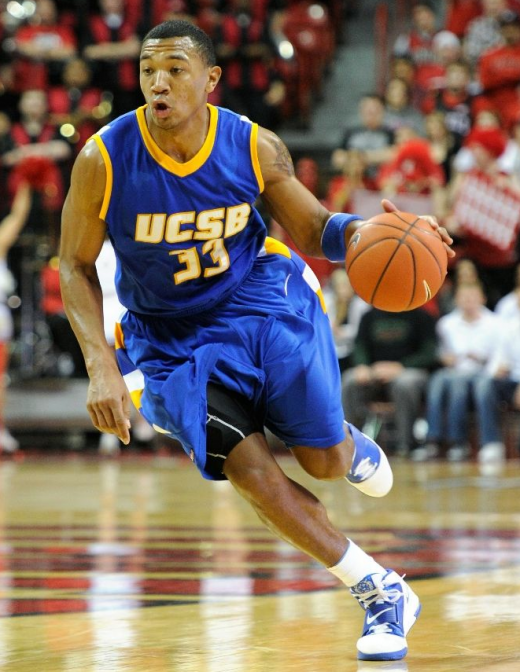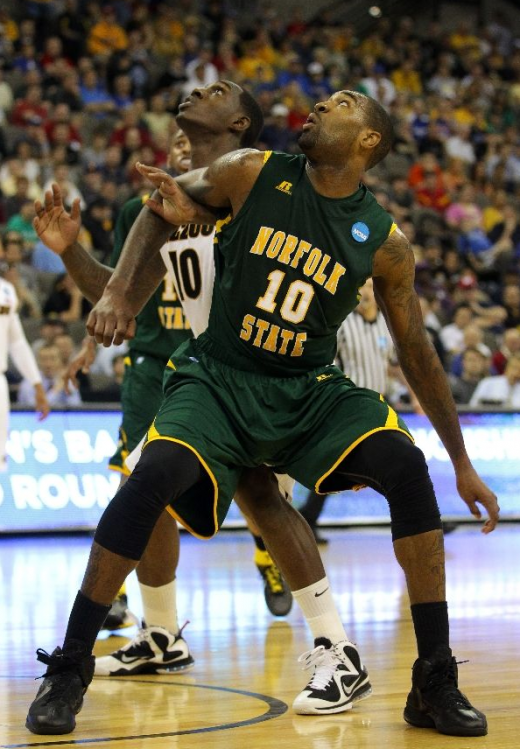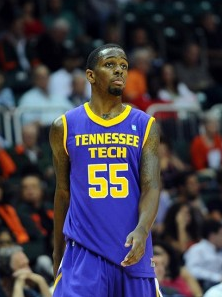Draft Profile: Orlando Johnson, Kevin Murphy and Kyle O’Quinn
2012-06-01Today, I bring focus back to Clevland’s later picks with three Senior mid-major draftees on the docket. Orlando Johnson, Kevin Murphy and Kyle O’Quinn expect to don their new team’s hat near Cleveland’s second-round selections.
Orlando Johnson of UC-Santa Barbara gained buzz at the recent New Jersey draft combine by measuring a 6’ – 11” wingspan and a 39” vertical. He is a 6’ – 5”, 220 pound shooting guard, who due to a redshirt season turned 23 years old in March. One of college basketball’s best scorers, he posted over twenty points per game on 56% true shooting, using his strength, length & deceptive ball-handling to find looks from the perimeter and at the basket. Most skilled as a shooter; he drained 43% of his threes this season, despite taking over five per game, with many off-the-dribble. Also functioning as a primary ball-handler in 2011 – 2012, he dished three assists per game versus only 2.5 turnovers. In contrast to the impressive leaping; his speed and agility are marginal, confirmed in New Jersey, where his sprint time ranks 119th of 128 drafted shooting guards in draftexpress’s database. These areas of weakness pose defensive concerns; however his length and size proved sufficient against UCSB’s schedule.
Kevin Murphy recently turned 22 and completed his senior year at Tennessee Tech. At the recent pre-draft Portsmouth Invitational, his scoring landed him on the honorary first-team, and his barefoot height of 6’ – 6” impressed scouts looking for NBA-sized shooting guards. Last year, with nearly 21 points per game, he finished as the NCAA’s 11th leading scorer, thanks to outstanding shot-making. Utilizing smooth athleticism, he exhibits a strong mid-range game, launching a variety of pull-ups and step-backs. Although connecting on a scintillating 42% of his long-range bombs impresses, his skinny 195 pound frame and propensity for jump-shooting leaves him converting only 45% of two-point attempts; 16th of 18 shooting guards in the 2012 draftexpress database. Marginal ball-handling and occasionally bad on-court decision making caused turnovers on over 18% of his used possessions. All combined, his offensive rating of 103 barely outpaces the NCAA’s average last season, which can only be partly blamed on high usage. Defensively, he is not elite, showcased by his 0.8 steals and 0.2 blocks per night.
Kyle O’Quinn of Norfolk State entered the national spotlight in a big way, exploding for a 26 & 14 in an NCAA tournament upset of second-seed Missouri. As the MVP at Portsmouth, thanks to weekly averages of nearly 12 rebounds and 4 blocks a game, his 7’ – 5” wingspan and quality leaping wowed scouts. Turning 22 this year, he accumulated 16 points, 10 rebounds and almost 3 blocks per outing, leading to dual honors of MEAC Player of the Year and Defensive Player of the Year. Offensively, he’s quite limited, both near the basket and on the perimeter, primarily utilizing his impressive size & strength to overmatch inferior opponents; of 345 Division One teams, Norfolk State played the 38th easiest schedule. His post repertoire relies too much on finesse, and he takes too many ill advised jump shots, including making only 19% of his three this year. On the bright side, he converted 70% of his free throws. At Portsmouth, his speed and agility tested well below-average, which confirms scouting reports on his play. These attributes, combined with an often non-revving motor, don’t allow him to maximize the formidable gifts that could otherwise make him an NBA defensive force.
Game Recaps: UCSB’s attempt to three-peat in the Big West Tourney was thwarted, as Orlando Johnson tallied 17 points, 6 rebounds and 6 assists in a 64 to 77 defeat to Long Beach State. Most of his damage came shooting off the dribble, totaling 13 points on 7 possessions, pulling up from mid-range to outside the NBA three. Although converting only one of four shots at the basket, he exhibited driving ability left-handed and right, and craftily changed pace to power his way into the paint. His ball-handling was non-elite though, as several plays featured bobbles or balls tipped away, without registering a turnover. His length and leaping were on display for really strong looking defensive rebounds, which he often uses to directly initiate the offense. He threw a lot of nice passes, but of his four turnovers, three occurred due to poorly conceived or lazy foists. Defensively, the Gauchos played a matchup zone, where Johnson sometimes seemed more likely to reach than rotate, and his slow-footedness was also apparent.
In losing a conference tourney semifinal to Murray State, Murphy dropped 31 points on 64% true shooting. Launching only 2 of his 21 field goal attempts in the immediate basket area; Murphy scored on pull-ups and step-backs, off hand-offs and around screens, banking shots from eight feet and swishing heaves from NBA range, while starting left and right equally. His constant attacking resulted in Ohio Valley conference defensive player of the year Jewuan Long battling foul trouble all game and playing only sixteen minutes. One issue mitigating the greatness of the performance though, consists of Long and his back-up being 6’ – 1”; Murray State played one player taller than 6’ – 7”, for five minutes. Defensively, both his strength and lateral quickness serve as weak-points. On at least three occasions, the small & fast “Racers” left him in the dust in isolation, and at only 195 pounds, his physicality battling screens suffers.
O’Quinn scored 18 points and grabbed 7 rebounds in leading Norfolk St to the Mid-Eastern Athletic Conference championship. The opponent, Bethune-Cookman, didn’t play anyone taller than 6’ – 7” or weightier than 210 pounds. That’s a large part of what makes this performance disappointing. On seven low-post possessions, O’Quinn generated only six points, four through fade-aways. Given his substantial size advantage, ideally he punishes the opposition with drop-steps and other power moves. This appears symptomatic of a larger “motor” issue, where a few possessions stand out. On one offensive trip, he made it down court and crossed the three point line after sixteen seconds ticked off the shot clock. On one transition defensive stand, where BC missed-and-missed-and-missed again, O’Quinn never entered the television screen, to which the announcers said he needs to “get his butt back on defense” and that they see too much of that. Half-hearted at that end; he recovered slowly on pick-and-rolls and was frequently beat off-the-dribble by his counterpart. Maybe simply bored with an over-matched opponent, he’ll definitely need to dial up the intensity to matter in the NBA.
Summary: Johnson dominated the Big West for a few seasons, winning two conference tournament MVP’s and one regular season player of the year. He will be 24 by the end of next season though, and I don’t think he’ll generate high-percentage looks in the NBA or be stout enough on defense. Much of the recent momentum in his draft stock rides on his losing 16 pounds between March and May. His explosiveness looks dramatically increased in workouts because of the improved physique. Is it really this easy for some people: “Maybe I’ll spend a couple of months getting in shape…NBA stardom, here I come!” I think “no” and that Cleveland should pass on him. If the answer is yes…well, life’s not fair.
Based on his performance at Portsmouth in the three-quarter court sprint, lane-agility drill, and vertical jump, some of Kevin Murphy’s most athletically similar pre-draft compatriots include Michael Redd and Caron Butler. Can the Tennessee Tech senior follow in the foot-steps of former second-round draftee Redd, and post a half-decade of twenty point per game seasons? My inclination is NO; he hasn’t been terribly efficient on offense, he won’t earn his bread on defense, and the competition is about to get bigger and more athletic. He won’t have the opportunity to dominate the offense like with the Golden Eagles. But he is a player that ESPN described as “a bit like a Richard Hamilton sort of player with much deeper range”. If available at #33 or #34, choosing to roll the dice on the tall jump-shooter from the mid-major may be a solid plan (I am biased though, as the Tennesse Tech athletic department fed-exed a DVD to me, and that was cool).
After the destruction of Missouri, O’Quinn followed up with 4 points and 3 rebounds against Florida in the second round of the NCAA tourney. If he maintains focus and displays constant effort, a career as a quality defensive force can he had. Given the lack of a consistent “motor” during his collegiate career and limited offensive upside, I think better opportunities exist at #33 and #34 for the Cavs.




Along the lines of talented 2nd round swingmen, http://www.draftexpress.com/profile/Will-Barton-5737/ has some really interesting upside. He’s got an interview on hoopsworld right now where he comes across as pretty eloquent.
HoopsDogg,
Between now and draft day, I plan on looking at Will Barton, hopefully having viewed a couple of his games. If they go big at #4 or #24, Barton is definitely worth a look at #33.
Orlando Johnson is very overated at best. I watched several UCSB games and lost interest in this guy quick. Love how he overcame adversity with the help of his brothers, Bou on the Court he was all about himself, watched him almost shoot UCSB out of games instead of getting his teamates involved.Had an Ego attitude at times and was spolied by his Coach who refused to get into is face when needed. He’s a bench warmer at best when UCSB went against bigger schools from tougher confrences he got circles ran around him. No Cleveland He’s not the one… Read more »
Sterling,
Thanks for the insight. My inclination was similar to yours, and it sounds like you’re coming from a stand-point of significant experience watching OJ.
Kevin,
I meant to add regarding O’Quinn and other motor challenged players, that Byron Scott doesn’t seem to be the kind of coach they need. His main means of motivation is playing time and that usually has ended up with the non self- motivating problem player ultimately leaving the team. I’m hoping Grant realizes this and doesn’t take a low motor player unless he exhibits character traits that show they are willing and able to learn to do things the right way. Guys that sulk under criticism need not apply, no matter how naturally gifted they are..
Kevin, On average 3-5 2nd rounders end up becoming solid rotation players or better. If Murphy became one of those for the Cavs he would fit a big need. He also was All Tournament team at the PIT. Another way I look at it is that his ceiling could be above Barnes’ floor??? Another big, who I really like what I’ve seen of, is Mindaugas Kupsas. He reminds some people of a young Z. He might be that store and stash in Europe big they need. It’s so hard to tell how good these guys are from watching highlights but… Read more »
Kevin Murphy is on my short list of players who could be a good second round addition for the Cavs. He fits an area of need as a shooter/scorer and his length could also improve another area of weakness. As with all of the late round selections, it really depends on who is available when the Cavs pick. Kyle O’Quinn strikes me as a viable second round pick along with Sims and maybe Sacre, if the Cavs don’t get a legit big man, size-wise. in round one. His may suffer from motorus interruptus but if I had to take a… Read more »
JAG,
I’m intrigued by Murphy, especially if the Cavs go big at #4 or #24. Also, for a second round big man, I’m holding out hope that Ezeli somehow lasts to 33-ish, so no need to think about O’Quinn.
You could be right. MI think I just like his vertical and wingspan. Murphy looks interesting, and Draft Express said he played well in Portsmith. I’m really hoping to find a gem with one of our second rounders, and I know someone is going to drop to there too. Kind of hoping the Cavs don’t get locked in on any one guy. Did you already cover ball hawking Jared Cunningham? I was really liking Jae Crowder till I found out he only measured 6’3.5″ barefoot. I don’t think a 6’3″ Mbah A Moute is going to work.
One other issue I have with Orlando Johnson is that 3/4 of the way through next season, he’ll be 24. He’s pretty much in his prime and if he has any chance in the NBA, he better be beating up on the guys at the second-tier New Jersey combine. Murphy probably won’t work out either, but he’s tall and a solid shot-maker…I give him a chance. I haven’t covered Jared Cunningham yet, and though I want to, Oregon State hasn’t sent me any game tape. That takes all the fun out of it. In addition to Crowder; Darius Odom-Johnson was… Read more »
Orlando Johnson is the only one of these three I’d take a flier on, and his lack of speed is concerning. Rarely do you see a guy with that kind of leaping ability be that slow. Makes me think that some of that speed may be coachable, and that he is probably a bit stiff in his running style. However, good size, good shooting, good ballhanding, makes me think that he could be an effective player in the half court, and probably have the ability to play some point. He was reportedly one of the best players at the NJ… Read more »
HoopsDogg,
I disagree and would prefer the flyer on Murphy. Johnson looks slow when playing. Also, he’s lost 15 pounds since the end of his senior year. How do we know that once he gets a guaranteed contract (if he’s picked late in the first) that he won’t suddenly lose his commitment to conditioning again?
I think he’s a three-and-D guy, without the D.